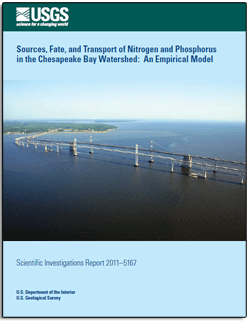Scientific Investigations Report 2011–5167

AbstractSpatially Referenced Regression on Watershed Attributes (SPARROW) was used to provide empirical estimates of the sources, fate, and transport of total nitrogen (TN) and total phosphorus (TP) in the Chesapeake Bay watershed, and the mean annual TN and TP flux to the bay and in each of 80,579 nontidal tributary stream reaches. Restoration efforts in recent decades have been insufficient to meet established standards for water quality and ecological conditions in Chesapeake Bay. The bay watershed includes 166,000 square kilometers of mixed land uses, multiple nutrient sources, and variable hydrogeologic, soil, and weather conditions, and bay restoration is complicated by the multitude of nutrient sources and complex interacting factors affecting the occurrence, fate, and transport of nitrogen and phosphorus from source areas to streams and the estuary. Effective and efficient nutrient management at the regional scale in support of Chesapeake Bay restoration requires a comprehensive understanding of the sources, fate, and transport of nitrogen and phosphorus in the watershed, which is only available through regional models. The current models, Chesapeake Bay nutrient SPARROW models, version 4 (CBTN_v4 and CBTP_v4), were constructed at a finer spatial resolution than previous SPARROW models for the Chesapeake Bay watershed (versions 1, 2, and 3), and include an updated timeframe and modified sources and other explantory terms. Chesapeake Bay receives an estimated 1.32 x 108 kilograms (132,000 metric tons) of nitrogen and 9.74 x 106 kilograms (9,740 metric tons) of phosphorus annually from its watershed, mainly through its two largest tributaries, the Susquehanna and Potomac Rivers. Significant (α=0.10) sources of nutrients to streams in the watershed include fertilizer and manure applications in agricultural areas, undifferentiated urban activities, point sources, atmospheric deposition and direct fixation by crops (for nitrogen), and mineral sources (for phosphorus). Agriculture (primarily fertilizer applications and crop fixation) contributes more than half of the nitrogen delivered from the watershed to the bay; phosphorus contributions are more mixed, and fairly evenly distributed among agricultural (fertilizer and manure applications) and urban (including point) sources. Natural mineral dissolution contributes approximately 14 percent of the phosphorus flux from the watershed to the Chesapeake Bay. Empirical estimates of average yields from different source areas and of the portion of selected applications delivered to streams agree closely with previously reported values in the literature. Nutrient fate and transport through the Chesapeake Bay watershed to the bay reflect the diferent physical and chemical properties of nitrogen and phosphorus compounds. Groundwater is an important pathway for nitrogen transport (as nitrate), and TN flux is greatest in areas with greater groundwater flow and in areas of the Piedmont underlain by carbonate rocks. TN flux decreases with increasing vegetative growth (likely indicative of plant uptake) and soil available water capacity (likely indicative of reducing conditions). Phosphorus transport to streams, conversely, is greatest in areas most likely to generate overland runoff and related erosion, including those with less permeable and more erodible soils and greater precipitation. Phosphorus transport also is greater in the Coastal Plain than in other areas, possibly due to saturation of soils with historical phosphorus applications. Both nitrogen and phosphorus are lost within watershed impoundments (lakes, ponds, or reservoirs), and nitrogen is also lost significantly along flowing reaches, particularly in small streams and in larger streams in warmer areas. |
Posted October 11, 2011
It is recommended that users right-click and save the report and data file. For additional information contact: Or Scott Ator, HydrologistMD-DE-DC Water Science Center 5522 Research Park Drive Baltimore, MD 21228 Email: swator@usgs.gov Part or all of this report is presented in Portable Document Format (PDF); the latest version of Adobe Reader or similar software is required to view it. Download the latest version of Adobe Reader, free of charge. |
Ator, S.W., Brakebill, J.W., and Blomquist, J.D., 2011, Sources, fate, and transport of nitrogen and phosphorus in the Chesapeake Bay watershed—An empirical model: U.S. Geological Survey Scientific Investigations Report 2011–5167, 27 p. (Also available at http://pubs.usgs.gov/sir/2011/5167/.)
Abstract
Introduction
Purpose and Scope
Methods
Stream Network Development
Calibration Data
Explanatory Data
SPARROW Model Calibration and Predictions
Model Limitations
Nitrogen and Phosphorus in the Chesapeake Bay Watershed
Watershed Sources
Fate and Transport
Flux to Chesapeake Bay and Major Tributaries
Summary and Implications
Acknowledgments
References Cited
Appendix. Reach-Scale Estimates of Mean-Annual Nitrogen and Phosphorus Fluxes in Streams of the Chesapeake Bay Watershed